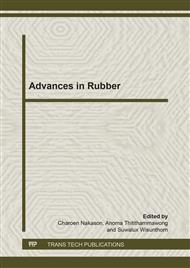p.235
p.239
p.243
p.247
p.251
p.255
p.259
p.263
p.267
Utilization of Recovered Palm Oil Fuel Ash as a Filler for Epoxidized Natural Rubber Composite: Influence of Filler Loading on Curing, Mechanical and Morphological Properties
Abstract:
Palm oil fuel ash (POFA) is used as a filler in epoxidized natural rubber containing 50 mole percent of epoxide groups (ENR-50). The potentiality of ENR-50 composite filled with POFA is investigated through the effect of different POFA loadings in a range of 0-60 phr on cure characteristics, mechanical properties and morphology. The chemical compositions and structure of POFA are also studied. It shows that POFA contains the major compositions of silicon dioxide or silica at 43.0 %wt and calcium carbonate at 20.3 %wt. The IR spectrum represents the important functional group of silanol. The cure characteristics of the composites are improved by reducing scorch time and optimum cure time with increasing POFA loading from 20-50 phr. However, they tend to increase slightly at high loading of POFA (i.e., 60 phr). Torque values (i.e., mimum torque, maximum torque and torque difference) increase with increasing POFA loading up to 40 phr, and then it decreases. Tensile strength of rubber vulcanizates containing POFA loading level at 40 phr exhibits the highest value. For elongation at break, it decreases while hardness increases regarding the increase of POFA loading. Morphology of the composites reveals that POFA particles show uniform dispersion and distribution in rubber matrix, but it moves toward the agglomerates formation at POFA loading beyond 40 phr.
Info:
Periodical:
Pages:
251-254
Citation:
Online since:
November 2013
Authors:
Keywords:
Price:
Сopyright:
© 2014 Trans Tech Publications Ltd. All Rights Reserved
Share:
Citation:


